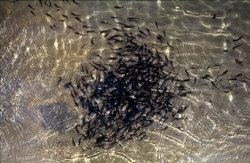
Stocking fingerlings
 Introduction
Introduction
Fish farmers need a reliable supply of healthy fingerlings to stock grow-out ponds. Farmers can produce their own fingerlings, purchase the fingerlings from hatcheries, or use a combination of both options.
Fingerlings have to be handled several times before stocking into ponds. The handling and husbandry at the hatchery, during transportation and subsequent stocking into ponds, can determine the success or failure of the grow-out phase. Poor husbandry can result in high mortalities or diseased fish. Problems with the fish may be noticed immediately or over a period of a few weeks following stocking.
Signs of stressed and/or diseased fish include emaciation (big head-small body), lethargy, loss of appetite, lesions or "patchy" skin, unusual colour, "flashing", frayed tails and fins, or opaque eyes. These signs may be associated with, or precede mortalities.
By following some simple procedures, the likelihood of these problems, occurring can be minimised.
Ordering Stock from Hatcheries
Place your order well in advance discussing issues such as mean weights, grading, weaning status (feed type and crumble/pellet size), size of order, parental genetics, cost and payment arrangements and delivery details.
Fingerlings harvested from a pond at the hatchery should be quarantined (stocked into tanks) and placed in a 5g/l NaC1 for at least 3 days. The salt solution reduces stress, prevents fungal infection and parasitic infestations. This process also allows the hatchery management to grade fish, discard weak fish or non-target species and "settle" (4 to 6 days) the fish prior to delivery to the farms. This process will ensure the fish are healthy and capable of withstanding the stress of transportation.
Taking Delivery
Preparation
Be prepared to receive the fingerlings. Have the tanks or ponds cleaned, filled and operational and check the water supply, aeration, pumps, etc are functioning correctly. Predator netting should be provided and a supply of appropriately sized feed on hand.
Inspection
Before unloading the fish, make sure the order has been filled correctly (species and number) and the fish appear healthy.
Quarantine
It is strongly advised to quarantine the fingerlings in tanks on arrival at the farm. Treatment with salt and a "settling" period of 3-4 days should follow. Tanks should have an abundant supply of high quality water and aeration.
Acclimatising
Fish will stress if there is a significant difference between the quality of "transport water" and the "receiving water" (tank or pond water). The younger the fish, and the greater the difference between the "waters", the less tolerant the fish will be. Both bodies of water should be monitored for pH and temperature. If the difference in these parameters is greater than one pH point (e.g. pH 7 and pH 8) or 2ºC respectively, the fish should be acclimatised over a period of 30 to 60 minutes. Acclimatising is achieved by slowly replacing the transport water with receiving water. Small bilge pumps and siphons are useful for this process.
Stocking the Fish
Anaesthesia
It is recommended that an anaesthetic be used for handling the fingerlings. The level of anaesthesia should only be "light" (fish remain upright) to maintain a low stress response followed by a quick recovery once stocked. Fish should be transferred between waters as quickly as possible.
Counting
With the use of an anaesthetic, bins and a set of scales, fish can easily be counted during stocking into tanks or ponds. The fingerlings are moved in small batches and the total weights recorded. By dividing the total weight of all the fingerlings with the mean individual weight, an approximation of the total number of fish stocked can be obtained. The mean individual weight is calculated by weighing and counting a small sub-sample. Fish should be kept in water as much as possible during this procedure.
Stocking into ponds
Particular care should be taken when stocking fish into ponds. Due to the ambient weather conditions and the effect of algae blooms, pond water can have significant differences in water quality compared to tank or transport water. Try to avoid stocking during the heat of the day. Fingerlings under anaesthesia, can become disorientated and "beach" themselves in areas of poor water quality.
Fish stocked into ponds can at times, become "un-weaned". This can be overcome by ensuring all fish are fully weaned prior to stocking or penning the fish into a small area of the pond where feeding can commence.
Stocking Density
It is recommended fingerlings be grown for 3-4 months during a "fingerling phase". Fingerlings can be stocked between 20,000 to 100,000 fish/ha depending upon each farms facilities, design, production schedule and expertise of personnel. A strict protocol of water quality monitoring, disease checking and feeding should be followed during this phase.
Feed size will depend upon the size of the fingerlings. Small fingerlings (0.5g) will consume "fines" whereas larger fish will need 1-3mm "crumble" feed. It is advisable to seek advice from the hatchery, prior to delivery, regarding the type and size of feed the fingerlings are consuming. At the end of the fingerling phase the fish should be harvested, graded and stocked into the grow-out ponds.
Communication
Following the delivery and stocking of fish, inform you hatchery manager of any problems, or changes you would like implemented. It is the responsibility of both the hatchery and the grower to ensure fingerlings are delivered and stocked in healthy condition.

